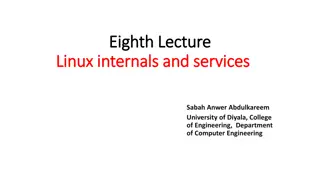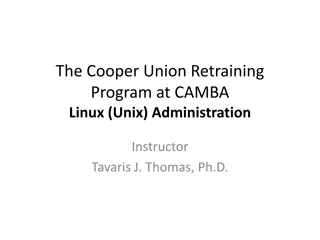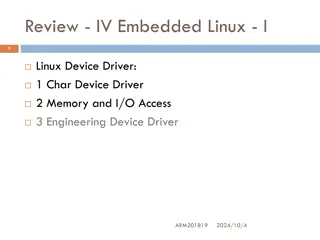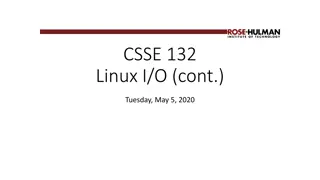
Analysis of Linux Scalability to Many Cores
This paper analyzes the scalability of Linux to many cores by investigating traditional kernel designs' efficiency on multicore architectures. The study conducted experiments with 8 different applications running on a 48-core computer, aiming to eliminate most kernel bottlenecks and enhance scalability using parallelizing techniques and introducing a new approach called "sloppy counters".
Download Presentation

Please find below an Image/Link to download the presentation.
The content on the website is provided AS IS for your information and personal use only. It may not be sold, licensed, or shared on other websites without obtaining consent from the author. If you encounter any issues during the download, it is possible that the publisher has removed the file from their server.
You are allowed to download the files provided on this website for personal or commercial use, subject to the condition that they are used lawfully. All files are the property of their respective owners.
The content on the website is provided AS IS for your information and personal use only. It may not be sold, licensed, or shared on other websites without obtaining consent from the author.
E N D
Presentation Transcript
AN ANALYSIS OF LINUX SCALABILITY TO MANY CORES Silas Boyd-Wickizer, Austin T. Clements, Yandong Mao, Aleksey Pesterev, M. Frans Kaashoek, Robert Morris, Nickolai Zeldovich (MIT) OSDI 2010
Paper highlights Asks whether traditional kernel designs apply to multicore architectures Do they allow efficient usage of architecture? Investigated 8 different applications Running on a 48-core computer Concluded that most kernel bottlenecks could be eliminated using standard parallelizing techniques Added a new one: sloppy counters
The challenge Multicore architectures Do we need new kernel designs? Barrelfish, Corey, fox, Can we use traditional kernel architectures?
The approach Try to scale up various system applications on A 48-core computer Running a conventional Linux kernel Measure scalability of 8 applications (MOSBENCH) using unmodified kernel Try to fix scalability bottlenecks Measure scalability of applications once fixes have been applied
Scalability Application speedup/Number of cores ratio Ideally, but rarely, 100% Typically lesser due to Inherently sequential part(s) of the application Other bottlenecks Obtaining locks on shared variables, Unnecessary sharing
Amdahls Law theoretical speedup of the execution of the whole task; speedup of the part of the task that benefits from improved system resources fraction of execution time that the part benefiting from improved resources originally occupied ?? ? ? 1 ??= 1 ? +? ?
Example: Flying Houston-New York Now Waiting at airport: 1 hour Taxiing out: 17 minutes Air time: 2 hours 56 minutes Taxiing in: 6 minutes Total time: 4 hours 19 mi Faster airplane cuts air time by 50 percent (? = 2) 178 60+17+178+6= 0.68 and ??= 1 = 1.515 ? = 0.32+0.68 2
MOSBENCH Applications Mail Server: Exim Single master process waits for incoming TCP connections Forks a child process for each new connection Child handles the incoming mail coming on a connection Include access to a set of shared spool directories and a shared log file Spends 69% of its time in the kernel
MOSBENCH Applications Object cache: memcached In-memory key-value store Single memcached server would not scale up Bottleneck is the internal lock handling the KV hash table Run multiple memcached servers Clients deterministically distribute key lookups among servers Spends 80% of its time processing packets in the kernel at one core
MOSBENCH Applications Web server: Apache Single instance listening on port 80 Uses a thread pool to process connections Configuration stresses the network stack and the file system (directory name lookups) Running on a single core, it spends 60 percent of its time in the kernel
MOSBENCH Applications Database: Postgres Makes extensive internal use of shared data structures and synchronization Should exhibit little contention for read-mostly workloads For read-only workloads With one core: spends 1.5% of its time in the kernel With 48 cores 82%
MOSBENCH Applications File indexer: Psearchy parallel version of searchy, a program to index and query Web pages Focus on the indexing component of psearchy (pedsort) More system intensive With one core, pedsort spends only 1.9% of its time in the kernel Grows to 23% at 48 cores
MOSBENCH Applications Parallel build: gmake Creates many more processes than they are cores Execution time dominated by the compiler it runs Running on a single core, it spends 7.6 percent of its time in the kernel
MOSBENCH Applications MapReduce: Metis MapReduce library for single multicore servers Workload allocates large amount of memory to hold temporary tables With one core: spends 3% of its time in the kernel With 48 cores: 16%
Common scalability issues (I) Tasks may lock a shared data structure Tasks may write into a shared memory location Cache coherence issues even in lock-free shared data structures. Tasks may compete for space in a limited-size shared hardware cache Happens even if tasks never share memory
Common scalability issues (II) Tasks may compete for other shared hardware resources Inter-core interconnect, DRAM, Too few tasks to keep all cores busy Cache consistency issues: When a core uses data that other cores have just written Delays
Hard fixes When everything else fails Best approach is to change the implementation In the stock Linux kernel Set of runnable threads is partitioned into mostly-private per-core scheduling queues FreeBSD low-level scheduler uses similar approach
Easy fixes Well-known techniques such as Lock-free protocols Fine-grained locking
Multicore packet processing Want each packet, queue, and connection be handled by just one core Use Intel s 82599 10Gbit Ethernet (IXGBE) card network card Multiple hardware queues Can configure Linux to assign each hardware queue to a different core Uses sampling to send packet to right core Works with long-term connections Configured the IXGBE to direct each packet to a queue (and core) using a hash of the packet headers
Sloppy counters Speed up increment/decrement operations on a shared counter 8 2 0 0 2 One local counter per core Represents number of pre-allocated references allocated to that specific core Global counter represents total number of committed references In use or pre-allocated
In the paper Counter used to keep track of reference count to an object Main idea is to pre-allocate spare references to cores In our example, 8 references 4 of them are pre-allocated references
Incrementing the sloppy counter (I) If the core has spare pre-allocated references Subtract increment from local counter 8 1 0 0 2 First core used one of its pre-allocated references Global counter remains unchanged
Incrementing the sloppy counter (II) If the core does not have any spare pre-allocated reference Add increment to global counter 9 1 0 0 2 Second core requested and obtained one additional reference Global counter is updated
Decrementing the sloppy counter Always Add decrement to local value of counter 9 1 1 0 2 Second core releases a reference Increments its number of pre-allocated references Does not update the global counter
Releasing pre-allocated references Always Subtract same value from global and local counter 7 1 1 0 0 Fourth core released its two pre-allocated references
How they work (I) Represent one logical counter as A single shared central counter A set of per-core counts of spare references When a core increments a sloppy counter by V First tries to acquire a spare reference by decrementing its per-core counter by V If the per-core counter is greater than or equal to V , the decrement succeeds. Otherwise the core increments the shared counter by V
How they work (II) When a core decrements a sloppy counter by V Increments its per-core counter by V If the local count grows above some threshold Spare references are released by decrementing both the per-core count and the central count. Sloppy counters maintain the invariant: The sum of per-core counters and the number of resources in use equals the value in the shared counter. sloppiness
Meaning Local counts keep track of the number of spare references held by each core Act as local reserve Global count keeps track of total number of references issued For a local reserve and being used
Example (I) Local count is equal to 2 Global count is equal to 6 Core uses 0 references 6 2 Core needs 2 extra references Decrement local count by 2 Local count is equal to 0 Global count is equal to 6 Core now uses 2 references 6 0 Core needs 2 extra references Increment global count by 2
Example (II) Local count is equal to 0 Global count is equal to 8 Core now uses 4 references Core releases 2 references Increment local count by 2 Local count is now equal to 2 Global count is equal to 8 Core now uses 2 references Core releases 2 references Increment local count by 2 8 0 8 2
Example (III) Local count is equal to 4 Global count is equal to 8 Core uses no references Local count is too high Return two pre-allocated references Decrement both counts by 2 Local count is equal to 2 Global count is equal to 6 Core uses no references 8 4 6 2
A more general view For your information only Replace a shared counter by A global counter One local counter per thread When a thread wants to increments the counter It increments its local value (protected by a local lock) Global value becomes out of date From time to time, Local values are transferred to the global counter Local counters are reset to zero
Example (I) 0 0 0 0 0 0 1 0 0 0 0 1 1 0 0
Example (II) 0 1 2 0 0 0 1 2 0 0 3 0 0 0 0
Lock-free comparison (I) Observed low scalability for name lookups in the directory entry cache. Directory entry cache speeds up lookups by mapping a directory and a file name to a dentry identifying the target file s inode When a potential dentry is located Lookup code gets a per-dentry spin lock to atomically compare dentry contents with lookup function arguments Causes a bottleneck
Lock-free comparison (II) Use instead a lock-free protocol Similar to Linux lock-free page cache lookup protocol Add a generation counter Incremented after every modification to the dentry Temporary set to zero during the update
Lock-free comparison (III) If generation counter is 0 Fall back to locking protocol Otherwise Remember generation counter value Copy the fields of the dentry to local variables When generation differs from the remembered value Fall back to the locking protocol.
Lock-free comparison (IV) Compare the copied fields to the arguments. If there is a match If reference count greater than zero Increment the reference count and return the dentry Else Fall back to the locking protocol.
Per-core data structures To reduce contention Split the per-super-block list of open files into per-core lists. Works in most cases Added per-core vfsmount tables, each acting as a cache for a central vfsmount table Used per core free lists to allocate packet buffers (skbuffs) in the memory system closest to the I/O bus.
Eliminating false sharing Problems occurred because kernel had located a variable it updated often on the same cache line as a variable it reads often Cores contended for the falsely shared line Degraded Exim per-core performance memcached, Apache, and PostgreSQL faced similar false sharing problems Placing the heavily modified data on separate cache lines solved the problem
Evaluation (after)
Note We skipped the individual discussions of the performances of each application There will not be on any test
Conclusion Can remove most kernel bottlenecks by slight modifications to the applications or the kernel Except for sloppy counters, most of changes are applications of standard parallel programming techniques Results suggest that traditional kernel designs may be able to achieve application scalability on multicore computers Subject to limitations of study






















